
Finding the best non-toxic yoga mats is very important for both your health and the planet.
When searching for a mat, pick ones made from safe materials like eco-friendly TPE and natural rubber. These materials are better because they do not have harmful substances like PVC, which can be bad for you and the environment.
Think about how well the mat grips, how long it lasts, and if it’s easy to carry. This will help you practice yoga better and safer.
Many people love Gaiam’s mats, as they come in different styles and thicknesses, plus they have great grip.
Interested in learning about the best choices for a cleaner yoga practice? Keep reading to find expert tips and reviews!
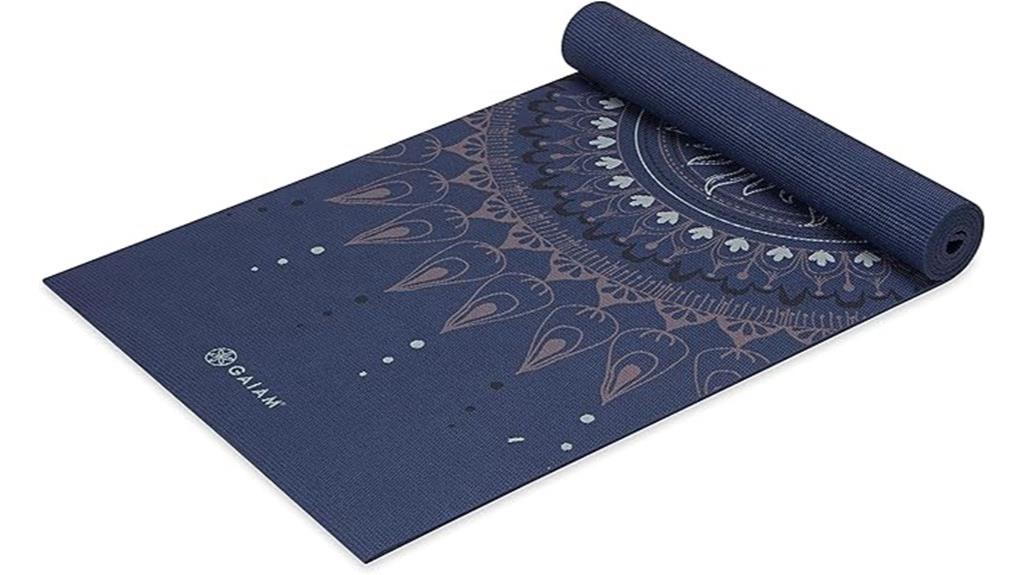
If you’re searching for a yoga mat that combines safety, comfort, and style, the Gaiam Yoga Mat – Premium 6mm Non Slip Exercise Mat is an ideal choice. With dimensions of 68L x 24W x 6mm thick, it offers superior cushioning for your joints during yoga, Pilates, or floor workouts. Made from non-toxic, 6P free PVC, it’s a healthier option for both you and the planet. Its sticky non-slip surface provides excellent grip, while the stylish design keeps you motivated. Though some might notice an initial odor, airing it out solves that problem quickly. This mat truly enhances your practice.
Best For: Individuals looking for a comfortable, non-toxic, and stylish yoga mat that provides excellent grip and cushioning during yoga, Pilates, and floor workouts.
Pros:
Cons:

The Gaiam Premium Reversible Yoga Mat is an excellent choice for eco-conscious yogis seeking a non-toxic option without sacrificing comfort or style. With a thick 6mm cushion, it offers support during yoga, pilates, or floor exercises, protecting your joints effectively. You’ll love the reversible design with two unique styles, letting you express your personal aesthetic. Plus, its textured, non-slip surface guarantees excellent grip and stability, making it easier to maintain proper alignment. Although you may notice a harmless odor when unwrapping, airing it out for a few days helps. Overall, it’s a popular pick, boasting a 4.6-star rating from thousands of reviews.
Best For: Eco-conscious yogis looking for a non-toxic and stylish yoga mat that offers comfort and joint protection.
Pros:
Cons:
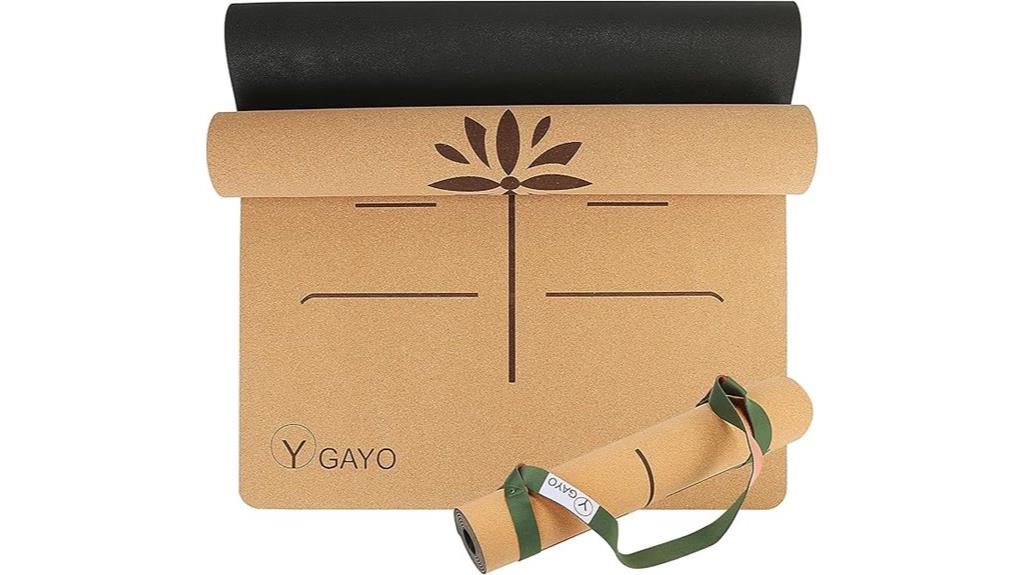
For eco-conscious yogis seeking a sustainable practice, the Premium Yoga Cork Mat with Natural Rubber Base stands out as an ideal choice. Weighing only 3.79 kg, this 5mm thick mat offers excellent grip and traction, ensuring stability in every pose. Made from renewable, biodegradable cork, it supports your commitment to the environment. You’ll appreciate the alignment lines helping position guidance, making it versatile for any yoga style. While some find it a bit heavier than standard mats, the included carrying strap makes transport easy. With a solid rating of 4.7 stars from users, it’s perfect for your next workout session.
Best For: Eco-conscious yogis looking for a sustainable and high-performance yoga mat.
Pros:
Cons:
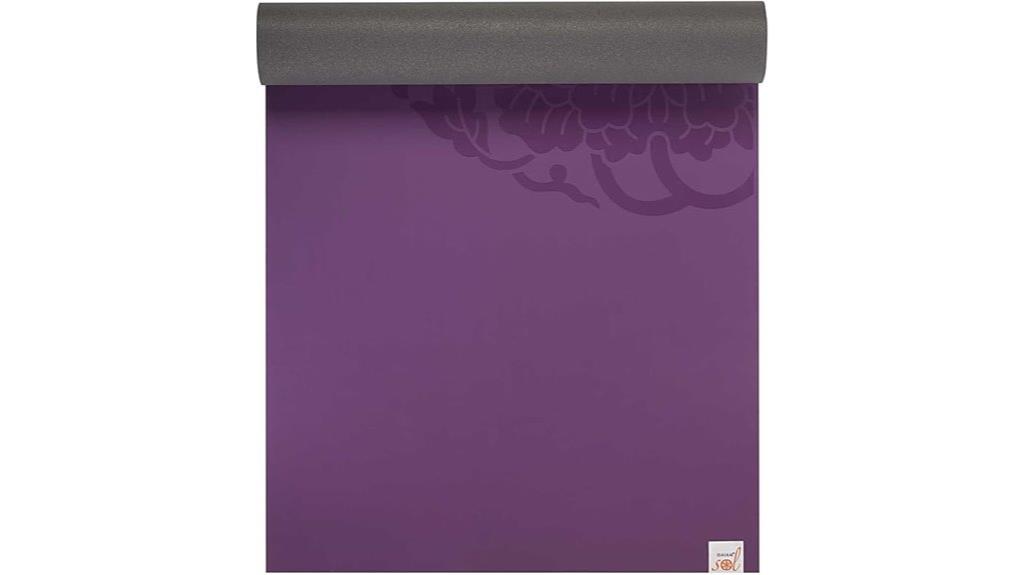
Looking for a yoga mat that can handle your hottest sessions? The Gaiam Dry-Grip Yoga Mat features a 5mm thick design that provides excellent support for both hot yoga and Pilates. Its non-slip grip guarantees you stay secure during poses, while the firm cushioning protects your joints. Measuring 68L x 24W inches, it’s lightweight at just 4.25 lbs, making it easy to transport. Though it may have a slight odor upon unboxing, airing it out for a few days resolves this. With an impressive 4.2-star rating, this mat is perfect for anyone seeking a reliable, non-toxic yoga option.
Best For: Hot yoga enthusiasts and those seeking a reliable, non-slip exercise mat for their workouts.
Pros:
Cons:
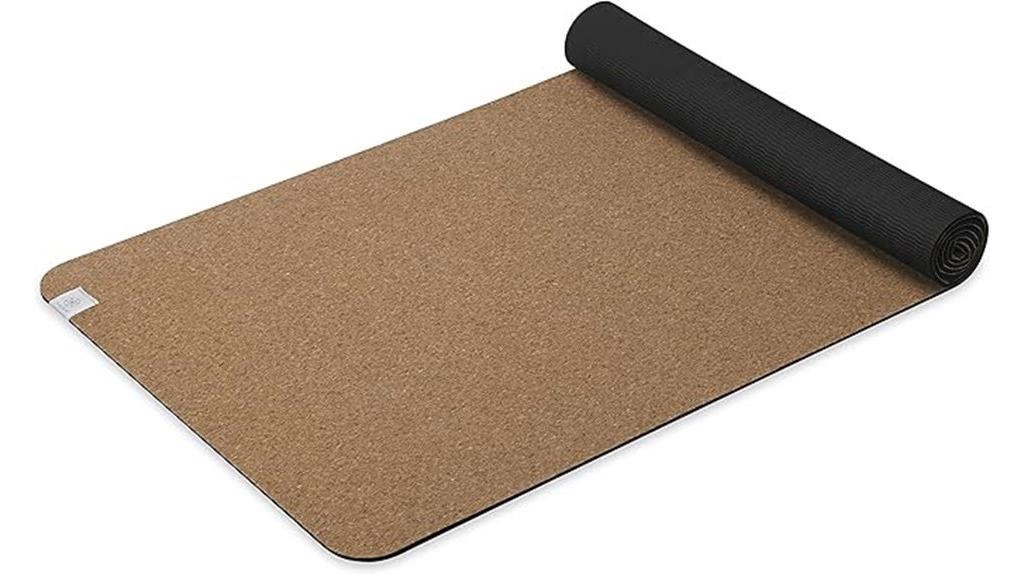
Experience the blend of comfort and eco-friendliness with the Gaiam Cork Yoga Exercise Mat, perfect for those who prioritize sustainability in their fitness routine. With its natural cork surface and eco-friendly TPE backing, this mat offers exceptional durability and traction, especially during hot yoga and intense workouts. Measuring 68″ x 24″ x 5mm, it provides plush cushioning for joint support. Users rave about its sweat and odor resistance, along with the non-slip design. Whether you’re practicing yoga, Pilates, or stretching, you’ll appreciate how this mat enhances your comfort and performance while promoting a greener planet.
Best For: Individuals seeking a sustainable and comfortable yoga mat for various fitness routines, including hot yoga and Pilates.
Pros:
Cons:
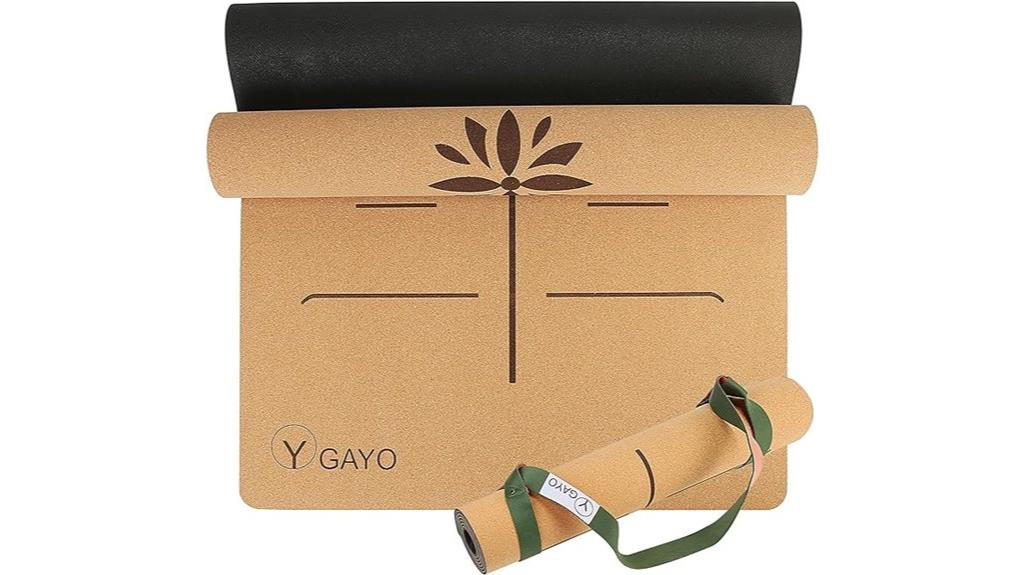
The Premium Yoga Cork Mat with a natural rubber base stands out as an exceptional choice for eco-conscious yogis who prioritize sustainability without sacrificing performance. Measuring 72 by 26 inches and 5mm thick, it offers excellent grip thanks to the natural cork surface, enhancing stability during your practice. Weighing 3.79 kg, it’s lightweight for portability and comes with a handy strap. Users love its cushioned feel and alignment lines that guide positioning. Plus, it’s non-toxic and made from biodegradable cork, promoting ecological responsibility. With a stellar 4.7-star rating, it’s perfect for diverse yoga styles and regular use.
Best For: Eco-conscious yogis seeking a sustainable and high-performance mat for various yoga practices.
Pros:
Cons:
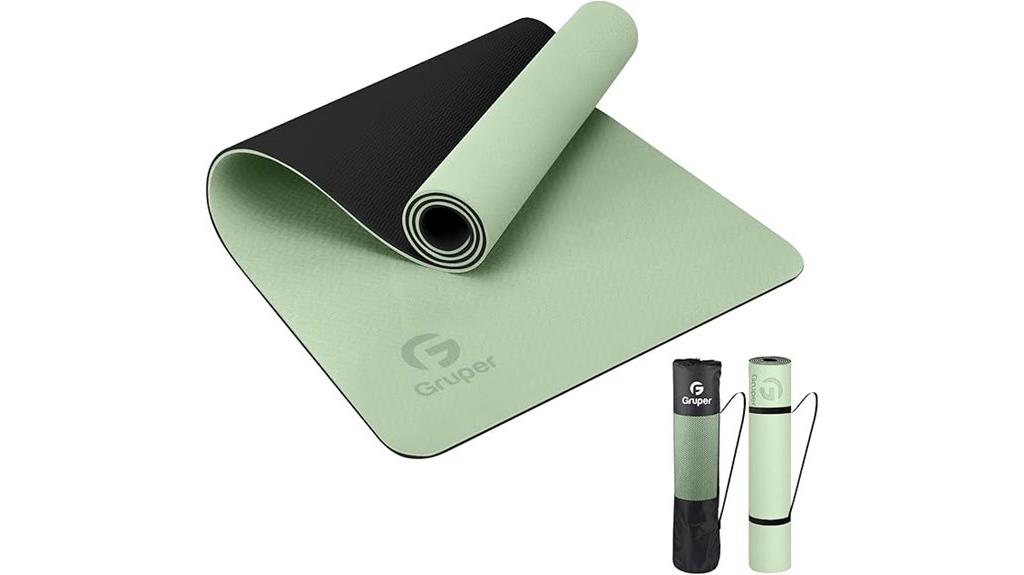
For those seeking a safe and healthy workout environment, the Non-Toxic Yoga Mat is an ideal choice. It features a non-slip, eco-friendly design made from premium materials, perfect for yoga, Pilates, and various fitness exercises. The special sticky texture guarantees best grip on both sides, while the double-layer construction enhances durability and resistance to tearing. Available in standard and thickened sizes, it provides excellent cushioning. Lightweight and portable, it comes with a free carrying strap for easy transport. With a 4.5-star rating from over 8,500 reviews, you’ll find it’s a reliable option for your practice.
Best For: Anyone looking for a durable and eco-friendly yoga mat that provides excellent grip and cushioning during workouts.
Pros:
Cons:
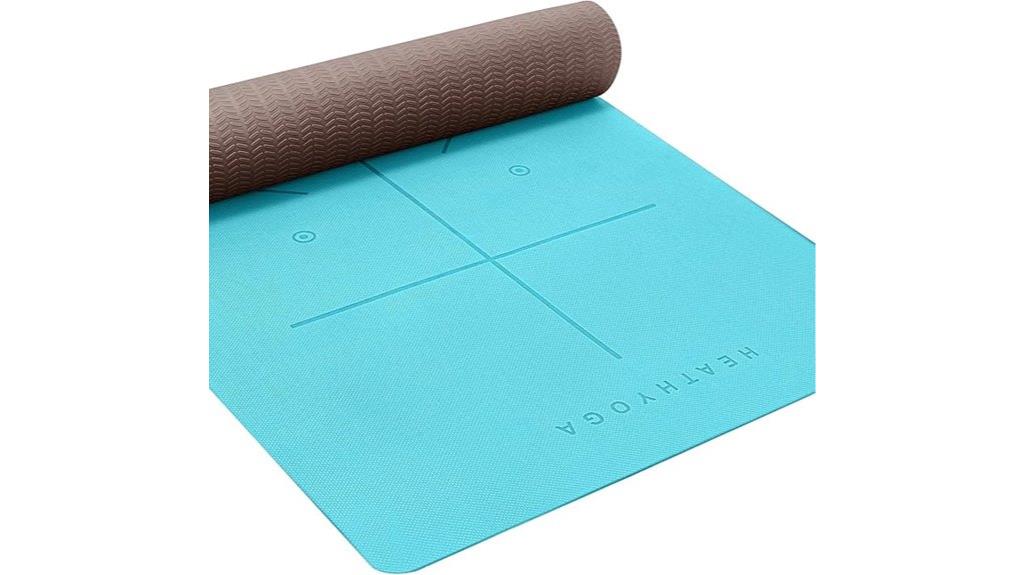
If you’re seeking a yoga mat that prioritizes both your health and performance, the Heathyoga Eco Friendly Non Slip Yoga Mat stands out with its innovative Body Alignment System. Measuring 72″ x 26″ and 6mm thick, it’s lightweight at just 2.8lbs, making it easy to transport. Crafted from SGS certified TPE, it’s free from latex, PVC, and heavy metals, ensuring a healthier option for your practice. The double-layer structure offers excellent grip and cushioning, while alignment lines help keep your poses precise. Users rave about its comfort and stability, making it a fantastic choice for any yoga enthusiast.
Best For: This yoga mat is best for health-conscious yogis seeking eco-friendly materials and features that enhance their practice.
Pros:
Cons:
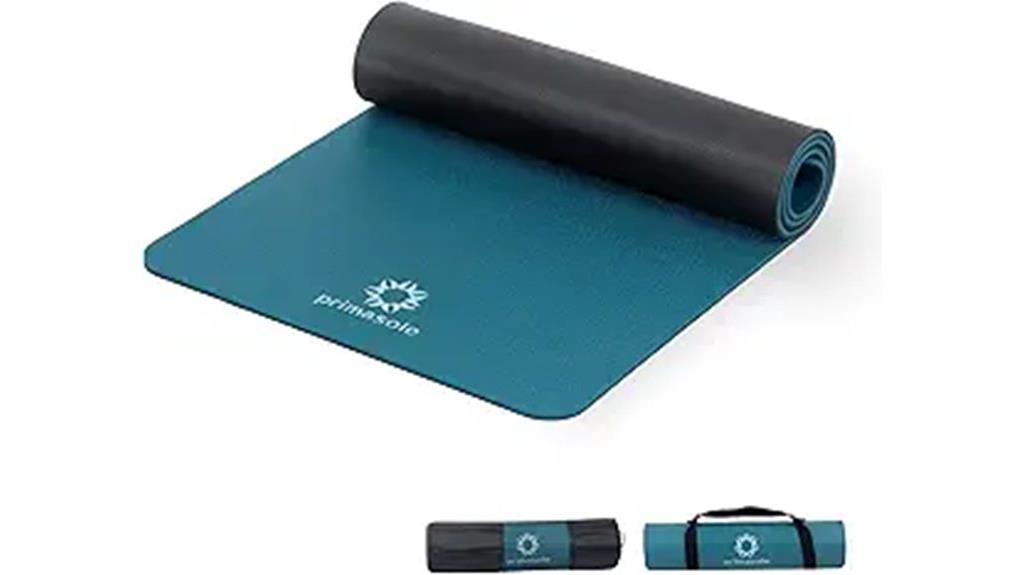
Looking for a yoga mat that prioritizes both your well-being and the environment? The Primasole Yoga Mat offers a non-toxic, eco-friendly solution crafted from polymer environmental resin. Measuring 68 × 24 inches and ½ inch thick, it provides the cushioning your joints need. Users appreciate its non-slip surface, making it ideal for various practices like Pilates and yoga. You’ll love the included carrying case and strap, perfect for on-the-go sessions. Just remember to air it out initially to reduce any chemical smell. While it’s suitable for a range of workouts, ongoing research on PER’s long-term safety is advised.
Best For: Individuals seeking a comfortable and eco-friendly yoga mat, particularly those with sensitive joints or who engage in practices like yoga and Pilates.
Pros:
Cons:

Designed with women in mind, the Yoga Mat Non-Slip, Eco-Friendly Anti-Tear Fitness Mat offers the perfect blend of comfort and safety for your home workouts. Manufactured from eco-friendly TPE, it’s free from PVC and harmful odors, ensuring a pleasant experience. The double-sided non-slip design, with textured wavy surfaces, gives you superb traction even during sweaty sessions. Measuring 72 x 24 x 1/4 inches (6mm thick), it provides ample cushioning and resilience for all skill levels. Plus, it arrives with a carrying strap and storage bag for your convenience. Enjoy eco-conscious practice while protecting our planet, one yoga session at a time!
Best For: Individuals looking for a comfortable, eco-friendly yoga mat that offers excellent grip and durability for home workouts.
Pros:
Cons:
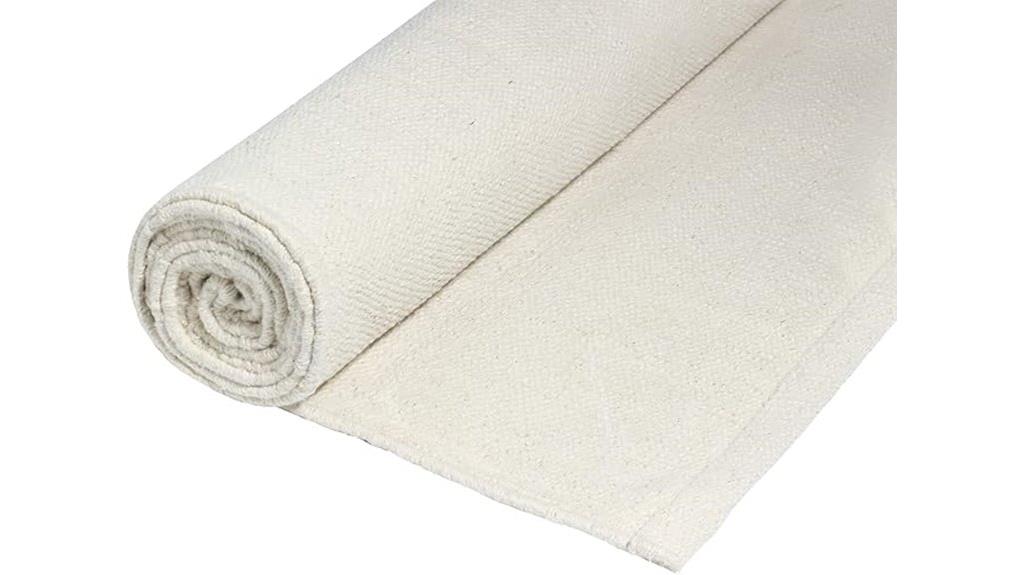
The Handmade Organic Cotton Yoga Mat is the perfect choice for anyone seeking a non-toxic and eco-friendly option for their yoga sessions. Weighing just 2 pounds, it features 100% organic cotton, ensuring it’s free from harmful chemicals. Its breathable and absorbent fabric provides comfort while you flow through poses. Plus, it’s machine washable, making maintenance a breeze. Handwoven by artisans in India, this mat supports fair trade practices. Ideal for indoor and outdoor settings, you’ll love its cushioned surface and soft texture. For added stability, consider using grippy socks, especially if you’re sensitive to odors or slippage.
Best For: Those seeking an eco-friendly, non-toxic yoga mat that prioritizes comfort and sustainable practices.
Pros:
Cons:
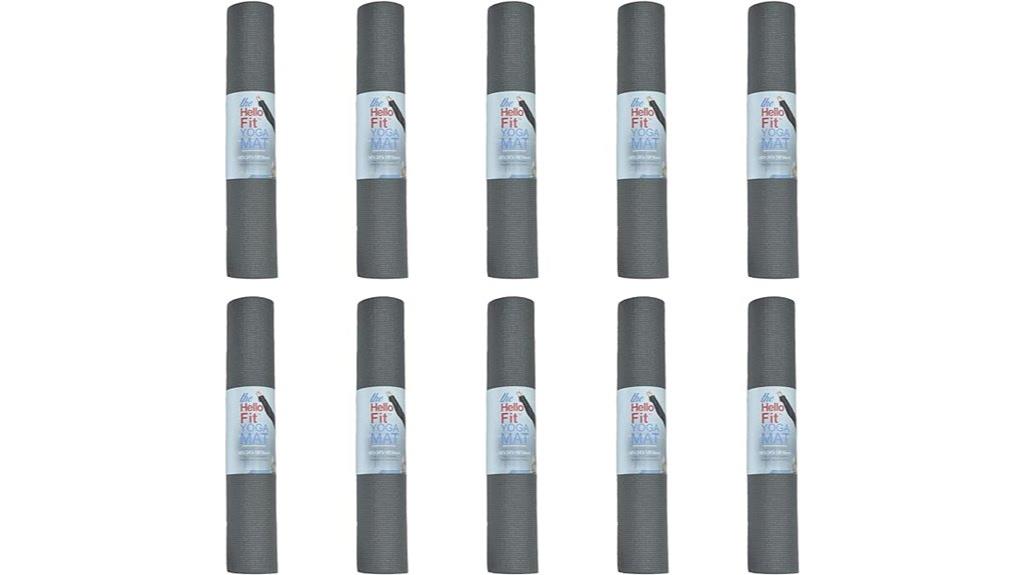
For fitness enthusiasts seeking a safe and economical option, the Hello Fit 10-Pack Non Slip Yoga Mat is an excellent choice. Each mat measures 68 x 24 inches with a comfortable 4.5mm thickness, perfect for yoga, stretching, or planking. Their non-slip surface provides great traction, while the closed-cell vinyl foam construction is easy to clean and liquid-resistant. Made from non-toxic, 6P Free Polyvinyl, these mats are free from harmful materials. With a 4.3-star rating from 372 users, you’ll appreciate their affordability and suitability for group activities, though some may find durability a concern after extensive use.
Best For: Budget-conscious fitness enthusiasts who need multiple yoga mats for group activities and comfortable workouts.
Pros:
Cons:

Looking for a yoga mat that balances safety and performance? The Gaiam Print Yoga Mat is perfect for your yoga, Pilates, and floor exercises. Measuring 68 inches by 24 inches and 4mm thick, it’s lightweight yet provides excellent cushioning for your joints. Its non-toxic PVC material guarantees you’re practicing safely, free from harmful phthalates. Plus, the stick non-slip surface offers great traction. With stylish, fade-resistant patterns, it enhances your workout space while being easy to clean. Many users rave about its grip and aesthetics, though some find it a bit thin. Enjoy a free downloadable yoga workout with your purchase!
Best For: Individuals seeking a reliable and stylish yoga mat for yoga, Pilates, and floor exercises with a focus on safety and performance.
Pros:
Cons:
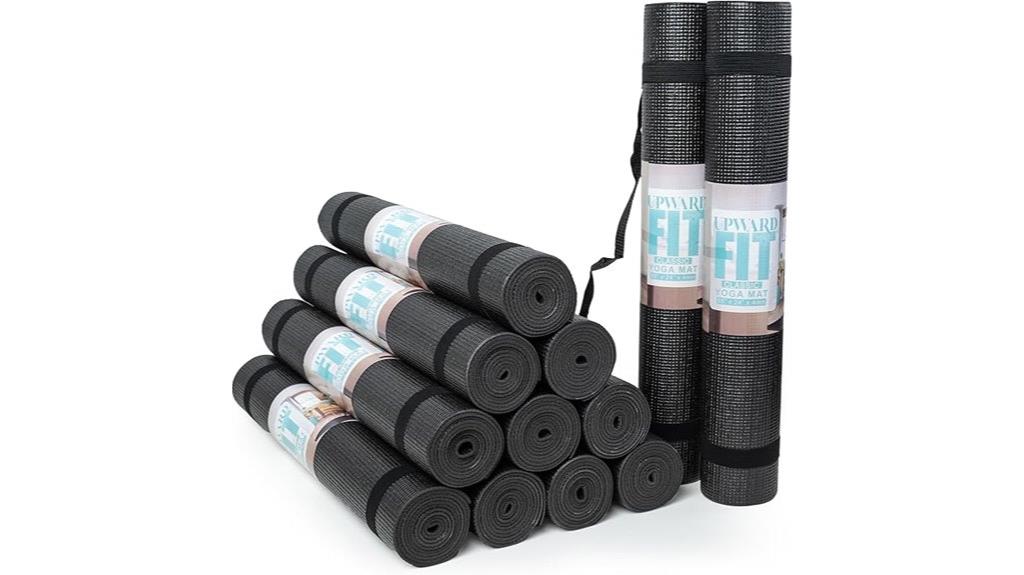
Designed with beginners in mind, the 12-Pack Classic Non Slip Yoga Mats with Carrying Strap offers an ideal solution for schools and studios hosting group activities. Each mat measures 68 x 24 inches and features a non-slip surface, ensuring stable footing during your poses. They’re made from high-quality closed-cell vinyl foam, free from harmful chemicals like latex and lead. Weighing in at 4mm thick, these mats cushion your knees and joints for max comfort. Plus, the included carrying straps make transportation a breeze. With a stellar 4.8-star rating, these mats are a fantastic, cost-effective choice for your practice.
Best For: This product is best for schools, studios, and beginners looking for an economical and practical solution for group yoga and fitness activities.
Pros:
Cons:
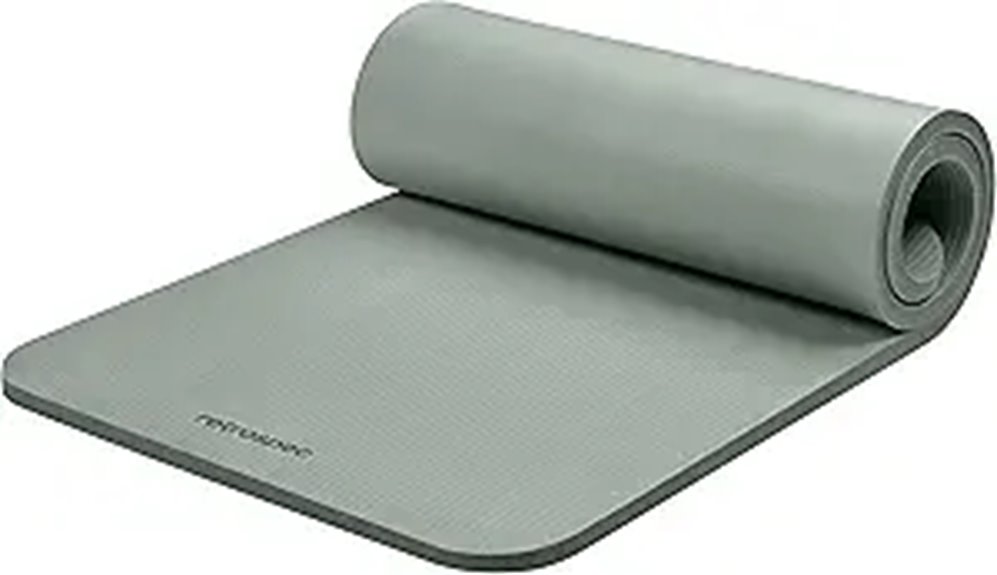
The Retrospec Solana Yoga Mat stands out as an excellent choice for anyone seeking enhanced comfort and support during their workouts, thanks to its extra-thick, 1-inch design. This mat alleviates stress on your joints, hips, hands, and knees, ensuring a more comfortable practice. Its non-slip surface provides stability, allowing you to focus on your yoga, Pilates, and stretching routines without worrying about slips. Crafted from durable materials, it’s perfect for everyday use and comes with a nylon carrying strap for hassle-free transport. Plus, it’s free of harmful chemicals, making it a safe and eco-friendly option for your workout needs.
Best For: Individuals seeking a comfortable and supportive yoga mat for daily workouts, including yoga, Pilates, and stretching routines.
Pros:
Cons:
When you’re choosing a non-toxic yoga mat, there are key factors you should consider to guarantee it meets your needs. Think about material safety standards, odor management, and environmental impact, as well as thickness for comfort and grip features. Each element can greatly influence your practice and overall experience on the mat.
Choosing a non-toxic yoga mat involves carefully evaluating material safety standards to guarantee your practice remains safe and eco-friendly. Start by checking that the mat is free from harmful substances like PVC, phthalates, and heavy metals. Look for mats that are certified 6P free, meaning they don’t contain six toxic phthalates often found in plastic products. Safer options include TPE and natural rubber, as they’re usually biodegradable and don’t release harmful chemicals. Ascertain the mat has SGS certification to meet strict safety and environmental standards. Additionally, consider mats made from renewable resources like cork or organic cotton, which not only reduce your ecological footprint but also foster a healthier practice space.
While you’re excited to start your yoga journey on a non-toxic mat, it’s essential to contemplate odor management practices to enhance your experience. Many non-toxic mats might release a harmless odor due to residual manufacturing chemicals, but don’t worry; this typically dissipates over time with proper care. To minimize initial odors, air out your new mat for 2-3 days in a well-ventilated area before use. Regularly clean your mat with a damp cloth to maintain hygiene and reduce lingering smells. Store your mat rolled up in a cool, dry place to prevent musty odors. Additionally, layering a towel during sweaty sessions can provide extra grip while absorbing moisture and odors, keeping your practice fresh.
As you explore options for non-toxic yoga mats, it’s crucial to take into account their environmental impact. Look for mats made from materials like TPE and natural rubber, as these are biodegradable and have a smaller footprint than traditional PVC mats. Opting for eco-friendly mats that are produced through sustainable manufacturing processes reduces emissions and waste, benefiting both you and the planet. Make sure to choose mats free from harmful substances like phthalates and heavy metals to protect personal and environmental health. Additionally, mats made from renewable resources, such as cork and organic cotton, show ecological responsibility. By selecting eco-friendly options, you support sustainable industries and ethical labor practices, positively impacting local economies and communities.
After considering the environmental impact of your yoga mat, it’s time to focus on how thickness affects your comfort and practice. Yoga mats typically range from 4mm to 8mm in thickness. A 6mm mat often strikes a balance between comfort and stability, offering enough cushioning for your joints without being overly bulky. If you have sensitive joints or injuries, a thicker mat around 10mm might be beneficial. On the other hand, if you prioritize balance, a thinner mat around 4mm can enhance your stability. Ultimately, choosing the right thickness should guarantee you have enough comfort to avoid strain while still connecting with the floor to support your poses effectively during practice.
Traction is a key aspect to evaluate when choosing a non-toxic yoga mat, as it helps you maintain stability and avoid slips during your practice. Look for mats with a textured, sticky surface that excels in grip, especially in sweaty conditions. Natural rubber or cork materials typically provide superior traction compared to synthetic options. If you’re considering the design, double-layer construction can enhance grip by offering stickiness on both surfaces. Thickness matters too; aim for mats that are about 5mm thick to achieve a balance between cushioning and stability. Some mats even include alignment lines, which can guide your positioning, further enhancing grip and your overall practice experience. Choose wisely, and you’ll improve your performance on the mat.
Choosing a non-toxic yoga mat involves not just considering its traction but also its durability and how to care for it. Mats made from natural rubber, cork, or eco-friendly TPE often last longer than traditional PVC. To keep your mat in good shape, clean it regularly with a damp cloth or mild soap, and avoid direct sunlight and harsh chemicals. Airing out new mats for a few days can help eliminate odors and improve comfort. Using a carrying bag or strap protects your mat from damage during transport. For textured surfaces, maintain grip by cleaning with a vinegar-water solution. Following these maintenance tips can extend your mat’s life and enhance your practice.
When selecting a non-toxic yoga mat, portability and storage are just as important as its eco-friendliness and grip. Look for mats that come with carrying straps or bags, making it easy to transport to and from your workouts. Choosing a lightweight mat, ideally under 4 lbs, will help with handling and storage. Opt for mats that can be rolled up compactly, avoiding memory retention like curling, to maximize your space, especially in small homes or studios. Double-layer construction mats enhance durability and can maintain their shape, guaranteeing they withstand frequent use while remaining easy to store. Finally, make sure the mats can be cleaned and dried flat for quicker packing and readiness for your next session.
Eco-friendly certifications play an essential role in ensuring that your yoga mat is not only safe for your health but also for the environment. Look for certifications like OEKO-TEX Standard 100, which guarantees textiles are tested for harmful substances. The Global Organic Textile Standard (GOTS) indicates at least 70% organic fibers and strict environmental criteria in production. Mats marked as “6P Free” lack six harmful phthalates, minimizing toxic exposure during use. Additionally, certifications from organizations like the USDA or Green Seal signal adherence to sustainable practices and eco-friendly materials. By choosing mats with these certifications, you can confidently support both your well-being and the planet.
To maintain your non-toxic yoga mat, use mild soap and warm water for cleaning. Wipe it down after each practice, avoid harsh chemicals, and store it in a cool, dry place to prolong its lifespan.
Yes, look for certifications like OEKO-TEX, GOTS, or ASTM. These indicate non-toxic materials and sustainable practices. Always check for labels that guarantee your mat’s safe, environmentally friendly, and free from harmful chemicals. It’s essential!
Non-toxic mats can vary in their recyclability and biodegradability. Some materials can be recycled, while others may break down naturally. You should always check with manufacturers for specific recycling options and environmental benefits.
The average lifespan of a non-toxic yoga mat is typically between three to five years, depending on usage and maintenance. Regular cleaning and proper storage can help you extend its durability for your practice.
You can use essential oils on your non-toxic yoga mat, but be cautious. Certain oils might degrade the material or leave stains. Always test a small area first, and consider dilution to protect your mat.
To sum up, choosing a non-toxic yoga mat is essential for a safer and more environmentally friendly practice. With options like the Gaiam mats and the Premium Yoga Cork Mat, you’ve got plenty of great choices. Remember to take into account factors like thickness, material, and grip to find the perfect fit for your needs. Investing in a quality mat not only supports your practice but also helps promote sustainability. So go ahead, roll out that mat and enjoy your sessions!
